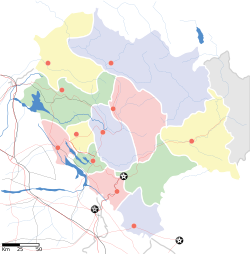Kangra, Himachal Pradesh
| Kangra | |
|---|---|
| City | |
| Location in Himachal Pradesh, India | |
| Coordinates: 32°06′N 76°16′E / 32.1°N 76.27°ECoordinates: 32°06′N 76°16′E / 32.1°N 76.27°E | |
| Country |
|
| State | Himachal Pradesh |
| District | Kangra |
| Elevation | 733 m (2,405 ft) |
| Population (2011) | |
| • Total | 9,528 |
| • Rank | 16th in Himachal Pradesh |
| Languages | |
| • Official | Hindi |
| Time zone | IST (UTC+5:30) |
Kangra is a city and a municipal council in Kangra district now in Indian state of Himachal Pradesh. Historically it was known as Nagarkot.
Kangra is a composite word made out of Kaann (meaning ear) + gaddha (create/mold). This name was given to Kangra because of the famous ancient plastic surgeons of the region who were known to provide plastic surgery for royals who wanted to improve their looks and warriors who had lost facial features during wars.
The British archaeologist and historian Sir Alexander Cunningham documented and brought to light the tradition and science of Kangra plastic operations. Although, modern plastic surgery uses the same techniques as the ancient techniques developed in South India, for north Indians Kangra's own unique methods were more popular and accessible.
Historically known as Nagarkot and "Trigarta." The town of Kangra was founded by Kshatriya Rajputs of Chandervanshi Lineage. The Katoch Rajas had a stronghold here, with a fort and rich temples.
Another ancient name of the city is Bhimagar and it was supposedly founded by Raja Bhim, younger brother of Kuru Emperor Yudhishthira of Indraprastha (now Delhi).
The temple of Devi Vajreshwari was one of the oldest and wealthiest in northern India. It was destroyed, together with the fort and the town, by 1905 Kangra earthquake on 4 April 1905, when 1339 lives were lost in this place alone, and about 20,000 elsewhere. In 1855 the headquarters of the district were removed to the cantonment of Dharmsala, which was established in 1849.
It is said that Mahmud of Ghazni looted a fort in the region in 1009, but whether the fort of Kangra was taken or not is not yet historically verified. There were hundreds of well-defended forts that lay between Ghazni and Nagartkot fort, and so it highly unlikely that his looting expedition ever reached Kangra. Also this claim is negated by Historians who have cited various sources to say that the fort was impregnable and remained unconquered until the conquest by Emperor Jehangir in 1622.
...
Wikipedia


